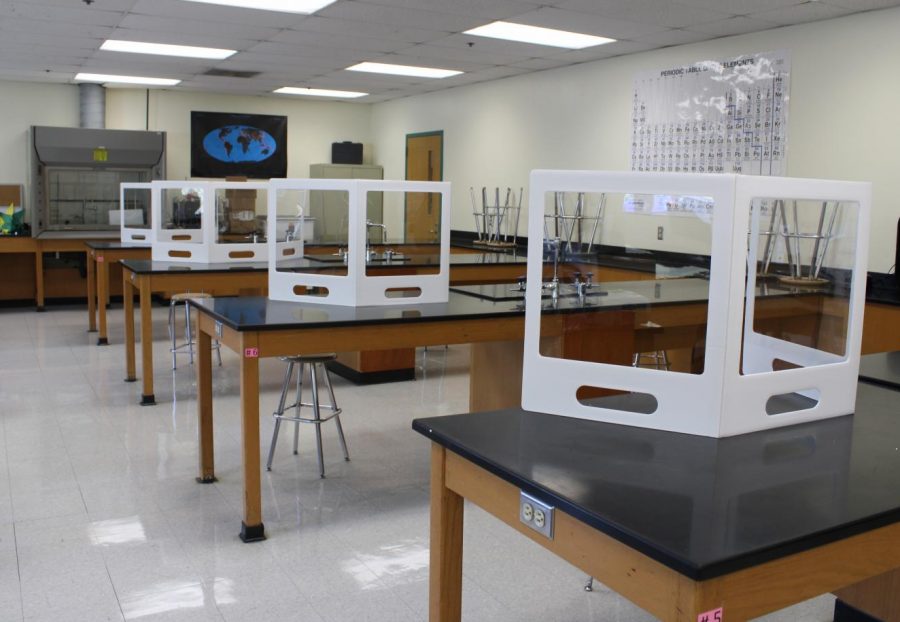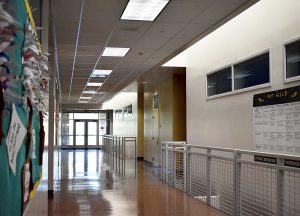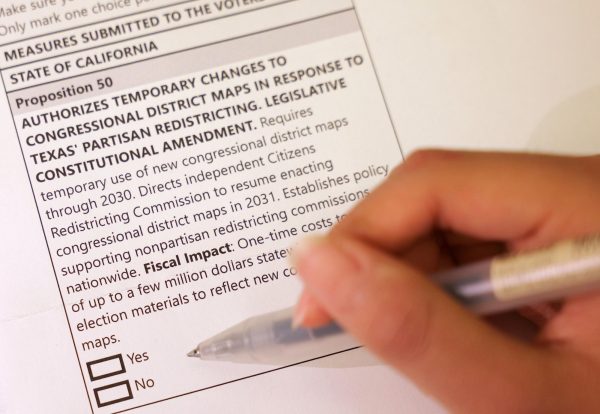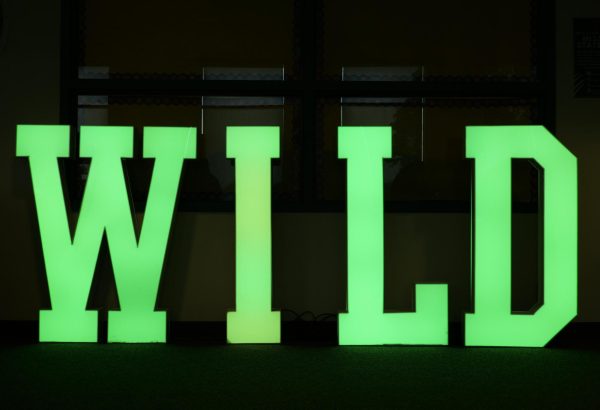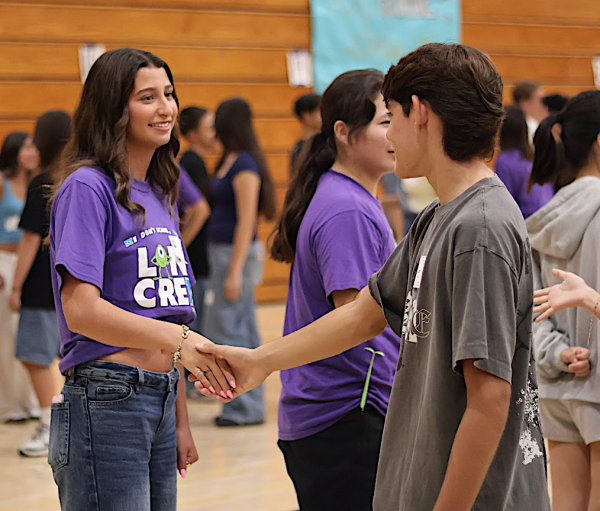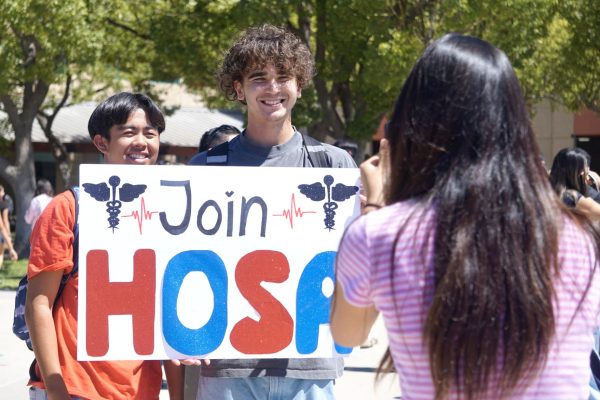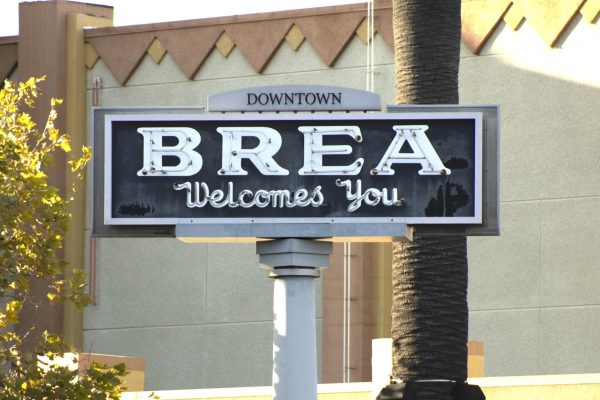Hybrid is Here: BOHS to Re-Open to Students Monday
Cardboard trifold shields sit atop a row of tables in a science classroom in preparation for the return of students for hybrid learning on Oct. 19.
From plexiglass shields attached to elementary school desks; to sticker arrows on sidewalks to ensure physical distancing; to installing hand-washing stations across district campuses; to supplying teachers with boxes of PPE, faculty, staff, and administrators throughout Brea Olinda Unified School District (BOUSD) are preparing for a safe first day of hybrid learning, which begins on Oct. 19.
Dr. Brad Mason, BOUSD superintendent, said he is “anxious to see students and staff return to school safely,” and is looking forward to the “vibrancy” of the learning environment that’s been missing since BOUSD schools closed due to the pandemic in March.
Preparations for the return have involved nearly every member of each campus’s staff, from custodians and food services personnel, to counselors and classified staff. Mason and his team, including Dr. Clayton Chau, the director of the Orange County Health Care Agency, and all of the district superintendents in Orange County, have been meeting every Friday for the last few months via Zoom in preparation for a safe transition to hybrid learning.
Starting Monday and Tuesday at BOHS, there will be about 650 students on campus in two cohorts, “A” and “B,” which divide the student body into two nearly-equal groups by alphabet to limit the number of students on campus at one time. Cohort A will attend school on Mondays and Thursdays, and cohort B will attend on Tuesdays and Fridays. All students will remain in distance learning on Wednesdays.
When parents of BOHS students drive up Wildcat Way to drop off their children for the first time since March 17, they will encounter two lanes: the outer lane will loop through the staff parking lot to the front of the main building, and the inner lane will go around the Wildcat statue.
As new and returning students step onto campus, they’ll see welcome decorations on walls and in stairwells posted by Link Crew leaders and ASB leadership. Link Crew will guide freshmen to class, and the ASB team will host festivities to welcome hybrid learners back to school.
Students can also expect:
- All students, teachers, and staff are required to wear masks and maintain six feet of distance to prevent the spread of COVID-19.
- Arrows and stickers on sidewalks and hallway floors to encourage distanced foot traffic have been placed by campus custodial crews.
- Six hand washing stations for student and staff use.
- Disposable water bottles at different locations on campus, which replace non-operable drinking fountains.
- An extra five minutes allotted to each passing period to allow teachers extra time to clean surfaces.
- For the remainder of the first semester, students that don’t have lunch will be provided a free lunch by BOUSD Food Services.
- Lunch tables will only allow two or three students per table, marked off by tape.
- Teachers have been provided disinfectant, paper towels, disposable gloves, and disposable masks (which students may use if they’ve forgotten their mask at home).
Before the start of hybrid learning, BOUSD teachers had a student-free prep-day on Oct. 13 to move into their classrooms, set up desk shields, receive training on technology and safety protocols, and prepare for the first day of hybrid learning.
In addition to the shields and an assortment of PPE, teachers received new hybrid learning technology, including USB cords, a camera, a tripod, and a microphone to enable live streaming.
Hybrid students are encouraged to bring internet-enabled devices to allow for continued use of Google educational tools like Docs, Forms, and Classroom. However, teachers will provide printed materials for those students who do not own, or who forget, devices.
The majority of BOHS students will remain in distance learning, according to a Wildcat poll of 362 students. The reasons why more students are opting to remain at home are varied: transportation issues, the convenience of learning at home, social anxiety, and the most mentioned reason — safety.
Some BOUSD students, like sophomore Kate Martinez, want to prioritize their safety over going to hybrid. Martinez said, “I chose distance learning because there are too many risks of going back, and the chemicals used to clean [surfaces] are very irritating to the skin. If I were to go back, I want to be 100 percent safe.”
Enzo La, sophomore, agrees with Martinez, and worries for her safety. “I’m choosing distance learning because I don’t feel comfortable going back to school yet. COVID is still active and getting worse, and going back would be putting myself and my family in danger,” La said.
But other students, like junior Antonio Alas, senior Brandon Godde, and freshman Sally Park, are choosing to attend hybrid learning to get out of their houses and learn in a “better” environment.
Alas said, “I went insane sitting in my dark room for hours on end, staring at a screen instead of enjoying life [in-person]. I never knew how extroverted I was until now.” He said he wants completely in-person learning, but knows that hybrid is a safe compromise at the moment.
Godde wants to take this opportunity to get fresh air and not be “locked” in his house anymore.
As a freshman who has not met any teachers in person, Park said, “Ever since [distance learning], I have not seen anyone except my family, and I would love to see my friends and new teachers now.”
Mia Choi, parent of three BOUSD students, will keep her children in distance learning due transportation challenges. “Since both my husband and I will be working, managing rides for all three of my kids who are attending different schools this year has become difficult,” Choi said. “Especially since they will be doing work on their computers either way, it made sense for our family to continue online.”
Some parents, like Gloria Corona, parent of a BOHS student, want to send their children to school to have in-person interactions with peers and teachers. Corona said, “We opted to have our son return to in-person instruction as it provides a higher level of interaction with teachers and results in stronger academic growth. We also believe that socialization and interaction with peers is an integral part of learning.”
Some teachers also expressed excitement for hybrid learning. John-David Williams, Brea Junior High English and Drama teacher, said, “As both a teacher and parent, I am very apprehensive of the current hybrid; I know though that we need to go through this step before we can return to normal practices. I’m looking forward to finally seeing my students in person. Seeing all those faces in little squares is not the same.”
Sera Yoon, BOHS and BJHS Korean teacher, has mixed feelings about the return to hybrid. “I am happy to see the students back as interaction in the classroom is important,” Yoon said. “However, hybrid does not allow too much classroom interactions.”
Alex Koers, English teacher, is also conflicted. “I’m excited to return to my classroom, which has been a second home for 17 years, but I do worry for my students’ and colleagues’ safety; and I’m anxious about how to meet the needs of both groups of students.”
A question on many student, parent, and teacher minds is: What happens when there is a case of COVID-19 on campus? If a student feels ill or has possible symptoms, they are advised to stay home and call their school. There is also a COVID-19 After Hours Hotline — 714-831-1040 — to report a medically confirmed case, and a letter of “low-risk” and “close contact” will be sent out to all staff and students, as stated in a message to the BOUSD community by Mason. Adrienne Thomas, assistant principal, said BOHS administrators will immediately inform parents and students in the event of a positive case.
Thomas said that BOHS administrators are prioritizing an environment of safety and respect. She wants to “make sure that kids aren’t mean and don’t make jokes when someone happens to sneeze. The best way you can take care of each other is not to point fingers and accuse, but to make sure others are healthy and you are healthy,” Thomas said.
In regards to the return of students on Oct. 19, Porter said, “Being physically in school has a positive impact not only on learning, but also our overall emotional state and well-being. We all miss the connection and time with students in person.”
Your donation supports the student journalists at Brea Olinda High School! The contribution will help us purchase equipment, upgrade technology, and cover our annual website hosting costs.
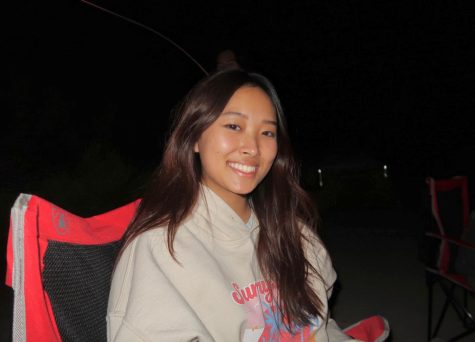
Doyon Kim, senior, is the Editor-in-Chief of the Wildcat, and this is her fourth and last year on staff. She loves binge-watching TV shows during her free...
Isabella Abalos, senior, is ecstatic about returning for her third year as one of the Photo Managers for the Wildcat. She enjoys going to the...


